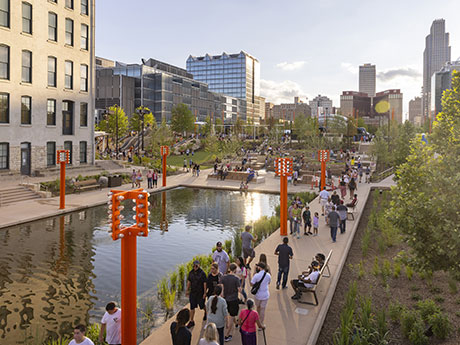By Sara Hanke, The Lerner Co.
Eternally optimistic is the state most commercial real estate brokers find themselves in, particularly when it comes to the retail sector. We must be, as the conditions of the retail market are quite often painted in negative broad strokes. The predictions that online sales would be the demise of physical retail proved wrong. Retailers that are digitally native continue to open brick-and-mortar locations after realizing the limits of online customer acquisition and growth.
Most recently, the pandemic has shown us that retail can weather the storm of restrictions and limitations. Now we are in a post-pandemic world where the restrictions and upheaval of the way we consume has shifted our mindset. Shoppers have returned to their daily shopping, eating and entertainment needs.

The Lerner Co.
Navigating the complexities of the retail real estate market continues to keep us all on our toes. The first and third quarters were healthy with vacancy dipping below 5 percent. So far, the third quarter has proven strong due to new-to-market concepts looking to do multiple location rollouts as well as existing retailers looking to add additional locations.
As the year progresses, we are not without challenge. There has been a shortage of Class A, geographically desirable sites. The slowdown of new builds in the retail sector, dating back to pre-pandemic times, is aiding in driving the per-square-foot rates up. The cost of construction and build-out is another reality we are facing, making it more difficult to get deals across the finish line. While demand has not come to a halt, we are showing signs of things slowing down slightly in the second half of this year.
Omaha has historically weathered economic changes well. Being a stable, more financially conservative city has helped us ride the most recent downturn. Mutual of Omaha, one of the many Fortune 500 companies headquartered in Omaha, is adding a brand new headquarters, changing the downtown city landscape with its 44-story skyscraper at 14th and Douglas, set to be complete in 2024. This new location leads into the newly redeveloped Gene Leahy Mall at The RiverFront that not only beautifies the downtown Omaha area but also helps drive foot traffic throughout the day and weekends.
Having a healthy core market has made a significant impact on how the other segments of real estate perform, directly affecting the daytime population that is so important to retailers and restaurants that call Omaha home. The downtown market has continued to see growth in 2023 where mixed-use developments such as The Capitol District welcomed a handful of new tenants and will be almost fully leased in 2024.
Growth and development in West Omaha and surrounding western suburbs has consistently been strong. Heartwood Preserve, the mixed-use development located along the West Dodge Corridor, is starting to take shape. This development has experienced shifts in both ownership and programming, but it recently got a new headquarters for Gunderson Jewler and the relocations of Mahogany and Charleston’s restaurants. Farther west retail developments include Coventry, a mixed-use development that includes a movie theater, restaurants and soon-to-be new hospital. Gretna, which was once a small community, is experiencing rapid growth adding multiple new schools to keep up with population demand and retail development is following. Gretna Landing is home to the largest Hy-Vee in the country and will be surrounded by many national retailers and restaurants in the next year.
Breaking down the segments of retail, you see even more nuances in growth. Car washes and entertainment-focused retail, specifically pickleball, have been the most talked about concepts this year. Discount retailers continue to see growth in our market, but they are finding similar challenges in site selection as the highly sought-after sites are being eaten up. It’s not just small to mid-size retailers filling up vacancy; we have seen a shift in the once ubiquitous big box vacancies as they start to fill up with the large-format entertainment concepts making anything above 10,000 square feet difficult to find.
Quick-service restaurants and coffee-driven concepts have not pumped the breaks and are filling up those prime drive-thru sites. Established chains such as Starbucks and Dunkin’ have increased year over year in foot traffic, and the new-to-market coffee users are hoping to take some of that market share. This is a positive reflection of the retail market and local economy, but we do anticipate slowing growth in the next six to 12 months as not all new-to-market or expanding retailers can afford new-build sites.
Retail investment and sales have cooled, with total deal volume down in the first half of the year compared with the same period in 2022. There is no doubt that the slowdown reflects rising interest rates and a natural adjustment from last year’s surge in sales.
Retail sales are likely to come under pressure during the second half of 2023 as economic growth slows and costs rise. Even with all the new development in our city, we are seeing limited supply. This, coupled with positive demand, will be putting us short of quality, relevant retail space as we head into 2024. Still, I stand by the statement that Omaha is an overall thriving and healthy market, and we will always be filled with optimistic real estate enthusiasts.
Sara Hanke is an associate broker with The Lerner Co. This article originally appeared in the October 2023 issue of Heartland Real Estate Business magazine.


